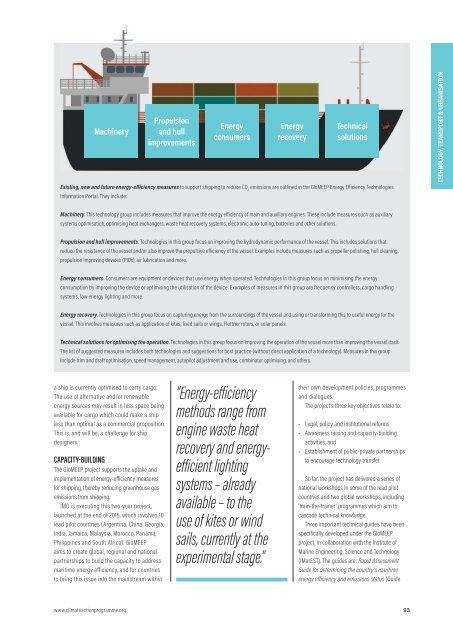Climate Action 2016-2017
Create successful ePaper yourself
Turn your PDF publications into a flip-book with our unique Google optimized e-Paper software.
Machinery<br />
Propulsion<br />
and hull<br />
improvements<br />
Energy<br />
consumers<br />
Energy<br />
recovery<br />
Technical<br />
solutions<br />
Existing, new and future energy-efficiency measures to support shipping to reduce CO 2<br />
emissions are outlined in the GloMEEP Energy Eff iciency Technologies<br />
Information Portal. They include:<br />
TECHNOLOGY, TRANSPORT & URBANISATION<br />
Machinery. This technology group includes measures that improve the energy eff iciency of main and auxiliary engines. These include measures such as auxiliary<br />
systems optimisation, optimising heat exchangers, waste heat recovery systems, electronic auto-tuning, batteries and other solutions.<br />
Propulsion and hull improvements. Technologies in this group focus on improving the hydrodynamic performance of the vessel. This includes solutions that<br />
reduce the resistance of the vessel and/or also improve the propulsive eff iciency of the vessel. Examples include measures such as propeller polishing, hull cleaning,<br />
propulsion improving devices (PIDs), air lubrication and more.<br />
Energy consumers. Consumers are equipment or devices that use energy when operated. Technologies in this group focus on minimising the energy<br />
consumption by improving the device or optimising the utilisation of the device. Examples of measures in this group are frequency controllers, cargo handling<br />
systems, low energy lighting and more.<br />
Energy recovery. Technologies in this group focus on capturing energy from the surroundings of the vessel and using or transforming this to useful energy for the<br />
vessel. This involves measures such as application of kites, fixed sails or wings, Flettner rotors, or solar panels.<br />
Technical solutions for optimising the operation. Technologies in this group focus on improving the operation of the vessel more than improving the vessel itself.<br />
The list of suggested measures includes both technologies and suggestions for best practice (without direct application of a technology). Measures in this group<br />
include trim and draft optimisation, speed management, autopilot adjustment and use, combinator optimising, and others.<br />
a ship is currently optimised to carry cargo.<br />
The use of alternative and/or renewable<br />
energy sources may result in less space being<br />
available for cargo which could make a ship<br />
less than optimal as a commercial proposition.<br />
This is, and will be, a challenge for ship<br />
designers.<br />
CAPACITY-BUILDING<br />
The GloMEEP project supports the uptake and<br />
implementation of energy-eff iciency measures<br />
for shipping, thereby reducing greenhouse gas<br />
emissions from shipping.<br />
IMO is executing this two-year project,<br />
launched at the end of 2015, which involves 10<br />
lead pilot countries (Argentina, China, Georgia,<br />
India, Jamaica, Malaysia, Morocco, Panama,<br />
Philippines and South Africa). GloMEEP<br />
aims to create global, regional and national<br />
partnerships to build the capacity to address<br />
maritime energy efficiency, and for countries<br />
to bring this issue into the mainstream within<br />
"Energy-efficiency<br />
methods range from<br />
engine waste heat<br />
recovery and energyefficient<br />
lighting<br />
systems – already<br />
available – to the<br />
use of kites or wind<br />
sails, currently at the<br />
experimental stage."<br />
their own development policies, programmes<br />
and dialogues.<br />
The project’s three key objectives relate to:<br />
• Legal, policy and institutional reforms<br />
• Awareness raising and capacity-building<br />
activities, and<br />
• Establishment of public-private partnerships<br />
to encourage technology transfer.<br />
So far, the project has delivered a series of<br />
national workshops in some of the lead pilot<br />
countries and two global workshops, including<br />
‘train-the-trainer’ programmes which aim to<br />
cascade technical knowledge.<br />
Three important technical guides have been<br />
specifically developed under the GloMEEP<br />
project, in collaboration with the Institute of<br />
Marine Engineering, Science and Technology<br />
(IMarEST). The guides are: Rapid Assessment<br />
Guide for determining the country’s maritime<br />
energy efficiency and emissions status (Guide<br />
www.climateactionprogramme.org 93












